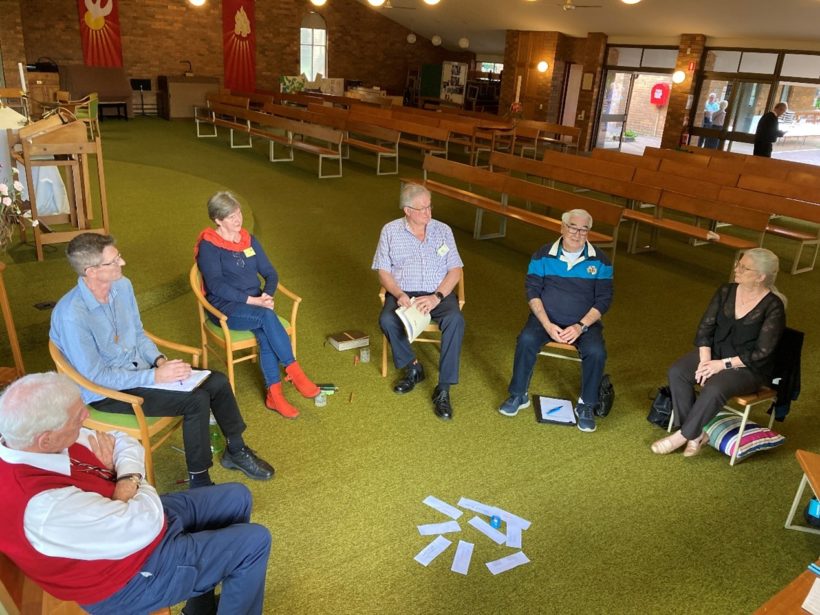Talking Circles – 8 tips for hearing the wisdom in the room
By Tim Booth, Ministry Development Officer, Parishes and Other Mission Agencies Commission
I first encountered a talking circle at a Quaker Sunday service in a circular room on a rainforested hill in the Brisbane suburb of Kelvin Grove. I entered the room to find people sitting in silence in a circle of chairs around a small central table. Sometime after I sat down, someone stood up, and speaking to the centre of the circle without looking around, shared about an issue that was concerning them. Rather than having a conversation, occasionally with considerable pauses in between, each participant who was so moved stood to speak their truth concisely, before sitting down again. By the end of our time together it felt to me like we’d tapped into a deeper wisdom, by allowing space for God’s Spirit to emerge amongst us.
A talking circle (or “listening circle”) is an intentional space where participants respond to a particular question or topic, with the complete attention of others in the room as each individual speaks their truth rather than bouncing off each other in conversation. Talking circles are valuable for churches and ministries because they enable an important topic to be explored in a way that each person’s perspective is clearly heard, without it being quickly judged or commented on.
With the recent shift back to in-person gatherings, talking circles are a great way to foster dialogue, with hybrid in-person/digital options also possible.
Here are eight tips to make your talking circle space suited for dialogue that matters.
- Set an intentional talking circle focus
Set an intention for the circle that is relevant and of interest to those gathered. This may be a question that is written on a poster or PowerPoint and/or spoken aloud. - Use a talking piece
Use a talking piece (a small object that fits comfortably in your palm) to enable one speaker at a time and a pause between each person speaking. It can be passed around the circle so people speak in their seating order (“talking piece council”), or replaced at the centre of the circle after each speaker for people to self-select when they speak (“conversation council”). - Speak with intention and listen with attention
When you are holding the talking piece, speak with intention – that is focused on the question and topic. Others should sit listening attentively, rather than thinking about what they want to say next. - Embrace the Apostolic number
As a rule of thumb, when the number of people exceeds 12, start a second talking circle, if possible, rather than crowding the space – unless there is an important reason to do so. Let Jesus’ selection of 12 Apostles be a useful guide here. - Check-in and check-out with talking circle participants
Use a check-in to initially connect those gathered by inviting people to introduce themselves briefly around the circle. Close with a check-out by asking participants to summarise a learning or take-away message and/or involve a closing activity – like saying “The Grace” together. - Make an agreement
At the start, discuss an “agreement” for how your respectful listening space will be maintained. Often this includes details about keeping confidential what is said and listening compassionately and curiously. - Guard the process
Have a “guardian” allocated for keeping an eye on the process, watching the energy levels in the room, and ensuring that the talking circle agreement is maintained. A pause can be called for by the guardian (or anyone else in the circle), for example by using a small bell or other signal. Other than this role, the leadership of the group is shared. - Experiment with topics that matter
Tailor your approach to different topics. Try talking circles for discussing topics:
- Where there are strong views and emotions by using carefully structured rounds of specific questions (e.g. the current Diocesan rounds of talking circle dialogue on the implications of two 2020 Appellate Tribunal determinations and opinions regarding the blessing of marriages between two people of the same gender. For example, the above image shows the Kenmore talking circle dialogue round on 3 May 2022 (with, left to right, John Cuffe, The Rev’d Tim Booth, Jen Bradbury, Jeff Bradbury, Graeme Curnow, and Deian Ping).
- To promote sharing through a gentle open-ended question for peer support (e.g. ministry colleagues meeting to share about their practices and offer mutual encouragement).
- Or to connect people through hybrid dialogues, combining in-person and online formats (e.g. by using Zoom, with online participants each having a talking piece to hold up when they want to speak).
Talking circles enable participants to speak with intention and listen with attention to explore a topic, so that all voices are heard and so collective wisdom may be discerned. As my Quaker service experience at Kelvin Grove taught me, talking circles are a counter cultural way of listening, and are well worth the effort of exploring an alternative space for dialogue. If you want to engage all your people, rather than the usual few dominant extroverted voices, to find the collective wisdom of God’s Spirit in the room, try using talking circles and see what emerges. Want to learn more about talking circles? Check out The Circle Way website and enjoy experimenting!
